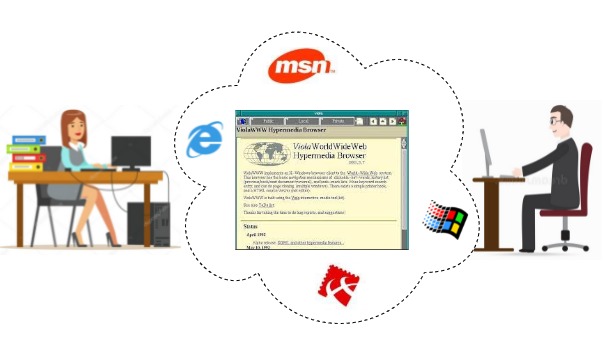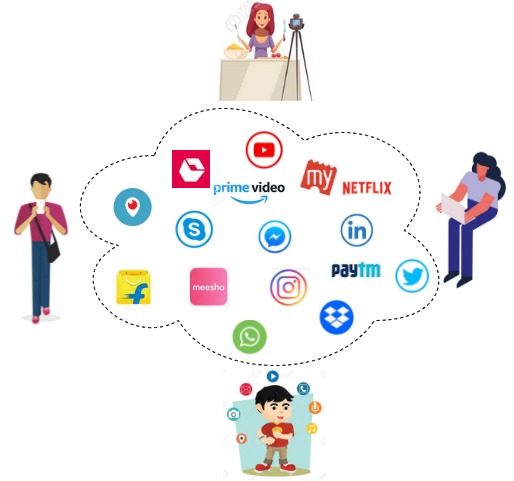Internet technology is often recognized as a significant innovation in computer science. Its impact is too rooted that life will not move in its absence. It has become the wheels of humans as the Internet is ingested, implanted and connected to humans in some way. When the covid pandemic brought the world to a near shutdown, it was the internet that kept it running.
This article aims to tale the evolution of the web, that you get to know from where and how the technology took its current form easing our different proceeds.
Well..the story goes something like this.
The evolution of the internet is often explained as Web 1.0, Web 2.0 and Web 3.0. The numbers 1.0, 2.0, 3.0 etc. do not mean ‘software/hardware update’ of the internet rather they denote the significant stages in the evolution of the internet.
Let’s get it explored.
So before we head, lemme clear it out that the terms- Internet and Web are different. Yes, it is often used interchangeably, but they are two different kinds. You know how???
While, the Internet points towards the technology of connecting devices, the web points towards collecting information in web pages or other web applications. This collection process was no single take. It evolved over time, maturing itself into a self-reliant powerful phenomenon.
Wanna know more? Here we go…… It all started with a static web.
Web 1.0: Static Web

The idea of the internet started to become popular in 1990s. For many people, the internet then meant “surfing the net” and “writing electronic mails”. This era was known as Web 1.0 or the static Web. Web 1.0 was characterized by static web pages which users in a passive mode surf. The content generation was done at the developer’s end. The websites of these times demanded little or no user input. It moreover worked in a read-only mode making it difficult for the users to find the right information they sought for. Later it was the introduction of graphics and video players at the 90s end that brought some user experience to the people leading towards the culture of a Social Web.
Web 2.0: Social Web
By the mid-2000s social media like Orkut and Facebook introduced the concept of the “social web” by providing platforms for communication among users. Followed by them, YouTube, Instagram, Twitter, LinkedIn, and wikis provided hosting user-generated content. It gave birth to content creators, bloggers and vloggers. This read-write mode of Web was noted as Web 2.0 and is the version that is currently running.

This era also witnessed technological advancements which made the Web run on any device- mobiles, tablets, watches… E-commerce applications proved that Web can also play the role of a marketplace. Users also play a significant role in deciding the fate of a product. User ratings and reviews influence consumer behaviour and determine the success of a product, which has urged companies to impose strict quality control measures.
The potential of the Web was further explored and recognized during the Covid-19 pandemic when people had to restrict their activities within the boundary of their homes. Can you imagine a day without internet access? Today people depend on the Web for anything and almost everything — purchasing groceries, buying meals, remote learning, remote working, watching movies, writing blogs and so on.
The Web 2.0 era is mainly about changes in the front-end to improve the design and use of online services. The real-time interactions powered by dynamic and visually impressive content provides a rich user experience. The exponential increase in the number of internet users proves the popularity of the Web. This era is also witnessing the rise of start-up companies and the surprise growth of some of them challenging the monopoly in various domains.
Web 3.0
Next is Web 3.0. What is Web 3.0 ? Let’s seek some external help,
“Alexa, what is web three …”
Well we just used a Web 3.0 application to search about Web 3.0. Voice assistants like Google assistant, Siri, Alexa, Cortana help you in your daily tasks right from setting alarms, reminders, cooking recipes, news, playing music, navigation, and so on. They recognize and “understand” your voice commands. They respond by making necessary adjustments in system settings or search the Web for results, tailor them according to your particular need and deliver it in a suitable format. In short we have trained “machines” to serve us like human assistants. There are machine-machine interactions also.

Unlike others, Web 3.0 is difficult to define. Many have used the term in the past. World Wide Web inventor Tim Berners-Lee defined Web 3.0 as “semantic web”. John Markoff of the New York Times addressed it as “intelligent web” whereas Ethereum co-founder Gavin Wood describes Web 3.0 as “decentralized web”. Indeed Web 3.0 applications justify all these titles. Though in the infancy stage, it is a really vast concept that is expanding at a rapid pace.
Let us see some of the main features of Web 3.0
Features of Web 3.0
rtificial Intelligence and Machine Learning techniques have enabled computers to interpret information like humans. For example, if you tell your Alexa or Google voice assistant “I am hungry”, it will instantly give you dining options available near your place. Language processing techniques can also help identify fake reviews and filter search results.
3D Graphics have made cyberspace more real and engaging. The advances in image rendering has greatly helped various domains like gaming, advertisements, education, technical designing etc.
The vast number of open-source software and associated applications have helped Web 3.0 to provide the read-write-execute facility. Moreover any device can be connected to the Web allowing web services accessible from anywhere. Thus Web 3.0 has increased user involvement to an advanced level.
Apart from this, there are some other reasons which make Web 3.0 more relevant.
Let us come back to Web 2.0. Most of the Internet content is searched on Google. When a person uses Google search engine, drive, messaging or email facilities, the user is actually sharing data with Google- a private company. Data breaches and privacy issues of many online services have topped the news several times.
Do you remember October 4, 2021 ?. The day when Facebook, Instagram, WhatsApp went down globally for over six hours leaving 3.5 billion users with no access to its social media platforms. A faulty configuration became too worse as it affected the centralized system.
Web 3.0 addresses these issues by some major changes at the “back-end”. We will see them in detail in the next article.
Image Courtesy: 123RF, VectorStock
